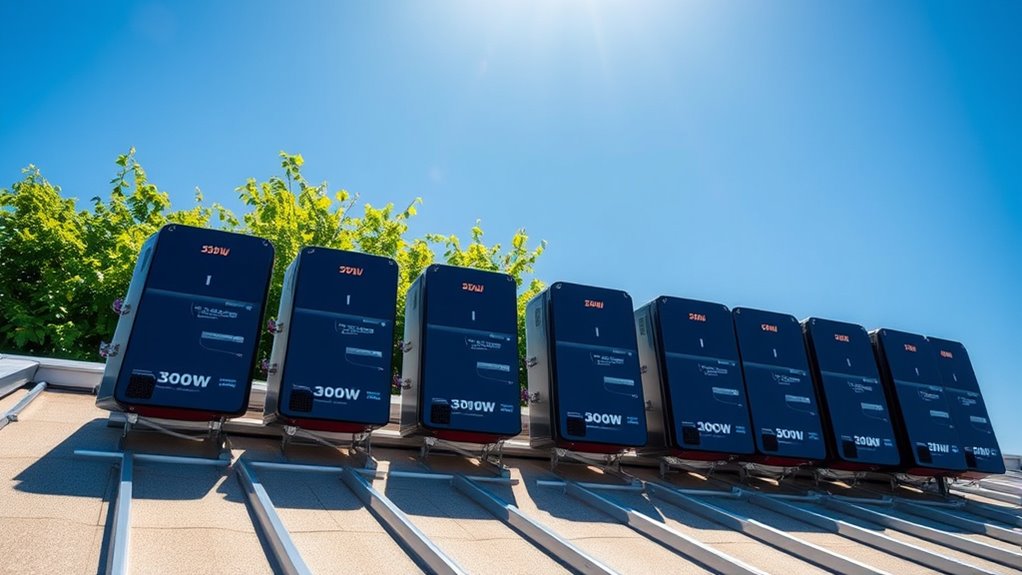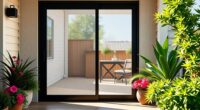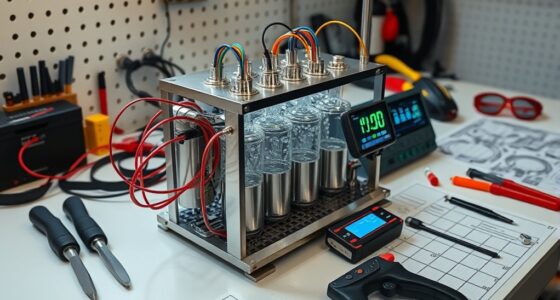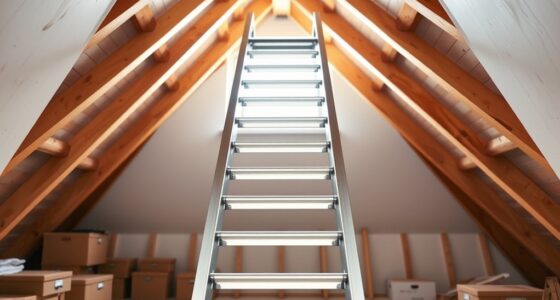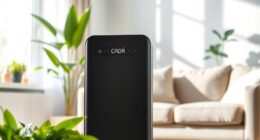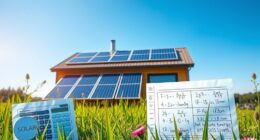If you’re searching for the best microinverter systems around 300W for maximum efficiency in 2025, I recommend considering models with high MPPT technology, durable IP65 waterproof ratings, and easy plug-and-play installation. Look for units with efficiencies over 92%, solid safety certifications, and compatibility with panels up to 36V or 50V. These features ensure reliable power conversion in shaded or small-scale setups. Stay with me, and I’ll help you find the perfect match for your needs.
Key Takeaways
- Focus on models with high peak efficiency (above 92%) and advanced MPPT technology for optimal energy harvest.
- Prioritize microinverters with durable, weatherproof designs (IP65 or higher) suitable for outdoor installations.
- Select units supporting multiple panels and flexible wiring configurations to maximize system scalability.
- Consider plug-and-play, easy-to-install models with integrated monitoring features for real-time performance insights.
- Ensure compatibility with panels up to 36V or 50V and verify safety certifications for long-term reliability.
1000W Low Frequency Pure Sine Wave Solar Inverter with MPPT Controller
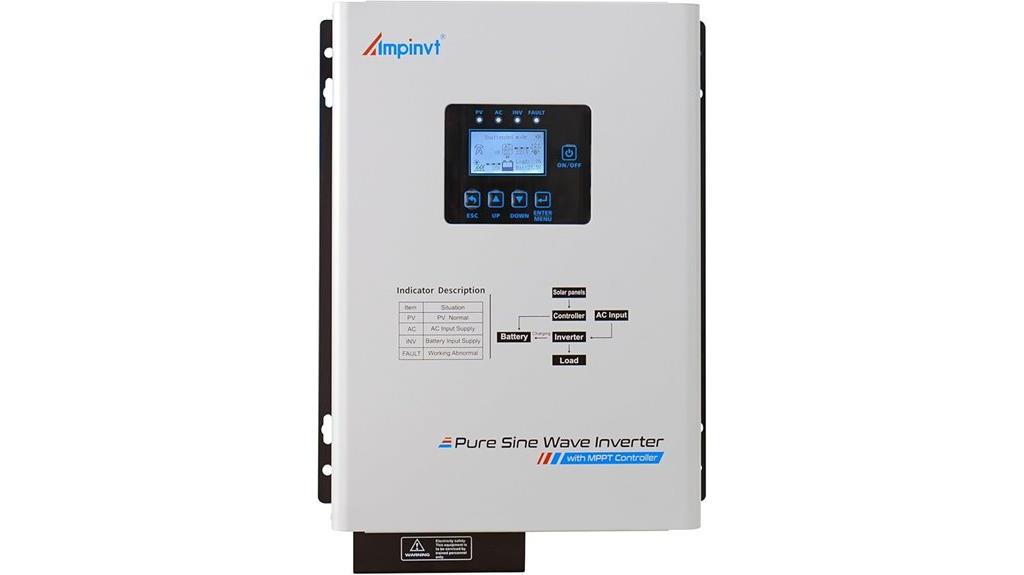
If you’re looking for a reliable inverter to power your off-grid or backup system, the 0W Low Frequency Pure Sine Wave Solar Inverter with MPPT Controller is an excellent choice. It converts 12V DC into 120V AC, combining inverter, battery charger, MPPT controller, and auto-transfer switch in one unit. Compatible with Lifepo4, lead-acid, and lithium batteries, it offers over 85% efficiency and stable pure sine wave output. Its built-in protections guard against voltage swings, overloads, and temperature issues. Designed for durability, it’s ideal for home backup or off-grid setups, ensuring reliable power delivery with features like adjustable charging and surge capacity.
Best For: homeowners and off-grid enthusiasts seeking a reliable, efficient inverter for backup power and renewable energy systems.
Pros:
- Combines inverter, MPPT solar charge controller, battery charger, and auto-transfer switch in one unit for convenience
- High transfer efficiency above 85% ensures minimal energy loss
- Compatible with various battery types including Lifepo4, lead-acid, and lithium for versatile applications
Cons:
- Some users have reported units arriving non-functional or experiencing electrical shorts
- Customer feedback indicates issues such as blank screens and reliability concerns
- Limited details on customer support and potential long-term durability
WZRELB 1000W Pure Sine Wave Inverter (48V DC to 110V/120V AC)
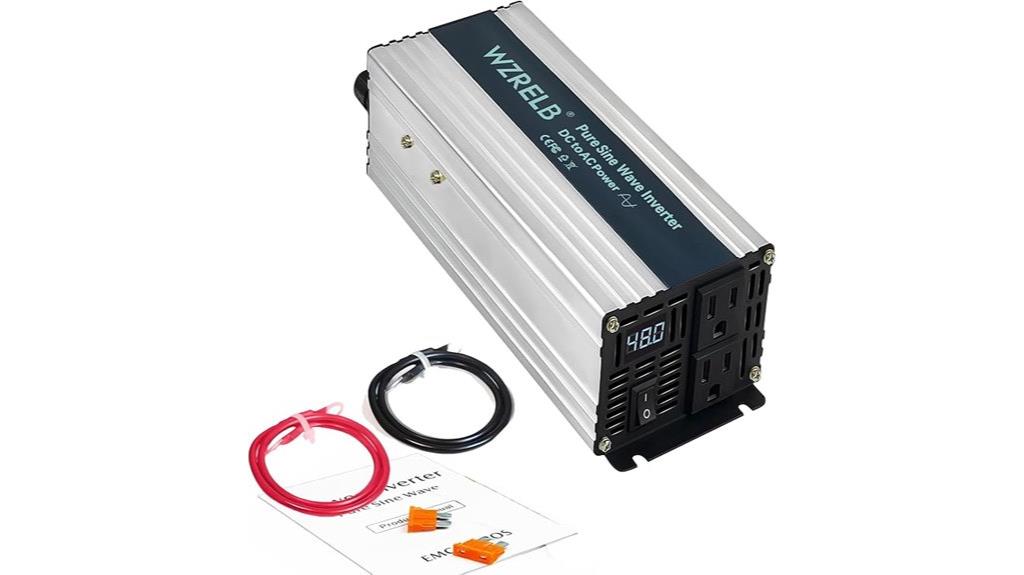
The WZRELB 1000W Pure Sine Wave Inverter is an excellent choice for those needing reliable, high-quality power conversion in off-grid or mobile setups. It transforms 48V DC into 110V/120V AC, providing 1000W continuous power with peaks up to 2000W. Built with pure copper inductance and imported MOSFETs, it guarantees stable output suitable for sensitive electronics. Its all-aluminum shell promotes heat dissipation, supporting higher temperatures. Compact and lightweight, it’s perfect for camping, RV, or emergency use. While the cooling fan can be loud, proper ventilation minimizes noise. Overall, it’s a dependable, versatile inverter for various off-grid applications.
Best For: off-grid homeowners, RV travelers, and emergency preparedness enthusiasts seeking reliable pure sine wave power for sensitive electronics and household appliances.
Pros:
- Provides stable 1000W continuous power with peaks up to 2000W, suitable for sensitive devices.
- Compact, lightweight, and portable design ideal for mobile and off-grid applications.
- Durable all-aluminum shell ensures efficient heat dissipation and reliable operation in various environments.
Cons:
- Cooling fan can be loud during operation, which may disrupt quiet settings.
- Some USB or socket connections might be inconsistent or require specific angles for proper contact.
- Runs warm under high loads, necessitating good ventilation or placement in well-ventilated areas.
Y&H 600W Solar Grid Tie Micro Inverter

The Y&H 600W Solar Grid Tie Micro Inverter stands out as an ideal choice for homeowners and small business owners seeking a straightforward, cost-effective way to connect high-powered solar panels to the grid. Its compact design and IP65 waterproof rating make installation simple and durable outdoors. Equipped with real-time monitoring via an LCD digital meter, it provides clear insights into voltage, current, and energy production. Supporting stacking and high-precision phase detection, it ensures efficient performance. Despite some overheating issues in warm weather, its affordability, ease of setup, and safety features make it a reliable option for maximizing solar energy utilization.
Best For: homeowners and small business owners seeking an affordable, easy-to-install solar inverter with real-time monitoring and outdoor durability.
Pros:
- Compact, weatherproof design with IP65 rating for outdoor use
- Easy plug-and-play setup with real-time LCD monitoring
- Supports stacking and high-precision phase detection for efficient performance
Cons:
- Overheating in warm weather can cause shutdowns and reduce efficiency
- Limited power output under cloudy or suboptimal sunlight conditions
- Some users report issues with waterproof fittings and limited customer support
Solar Grid Tie Micro Inverter (700W)

A 700W solar grid tie micro inverter is ideal for small-scale solar setups that require reliable, efficient power conversion. I’ve found this model offers built-in MPPT for optimized energy collection and boasts a high reverse transmission efficiency of 99.9%. Its pure sine wave output ensures clean power, suitable for grid connection. Despite some limits with panels over 30V, it performs well with 18-50V input, delivering around 156W AC from a 14.2V source. Its compact size and lightweight design make installation straightforward, especially when paired with proper heat management. It’s a cost-effective choice, especially for shaded or partial sunlight environments.
Best For: small-scale solar enthusiasts seeking a reliable, cost-effective micro inverter for shaded or partial sunlight conditions with moderate voltage panels.
Pros:
- Built-in MPPT algorithm for optimized power collection and increased efficiency
- High reverse transmission efficiency of 99.9% ensures minimal energy loss
- Compact, lightweight design simplifies installation and integration
Cons:
- Limited to 18-30V input range, making it incompatible with panels exceeding 30V without modifications
- Runs hot during operation, requiring additional cooling measures for prolonged use
- Not a true MPPT device for all setups, potentially limiting maximum power output in some configurations
Solar Grid Tie Micro Inverter for Solar Power System (300W)

If you’re looking for an efficient, easy-to-install solution for small-scale solar setups, a 300W grid tie micro inverter is an excellent choice. It converts DC power from your panels into AC power compatible with the grid, featuring MPPT to maximize energy output with tracking power up to 0.99. With a maximum efficiency of 93%, it guarantees minimal energy loss. Its compact, plug-and-play design allows quick connection without complex wiring. Made from durable aluminum alloy and rated IP65 waterproof, it withstands harsh environments. Supporting up to 6 units at 120VAC or 12 at 230VAC, it’s a reliable, safe solution for small solar systems.
Best For: homeowners and small-scale solar system users seeking an efficient, easy-to-install micro inverter for grid-tied solar energy conversion.
Pros:
- High conversion efficiency of up to 93% maximizes energy output.
- Compact, plug-and-play design simplifies installation and setup.
- Durable construction with IP65 waterproof rating ensures reliable operation in harsh environments.
Cons:
- Supports only up to 6 units at 120VAC or 12 units at 230VAC, limiting scalability for larger systems.
- Maximum power tracking efficiency of 0.99 may still leave some energy unharvested.
- May require careful installation to avoid exceeding maximum VOC input voltage from panels.
Y&H 500W Grid Tie Micro Inverter for Solar Power Systems
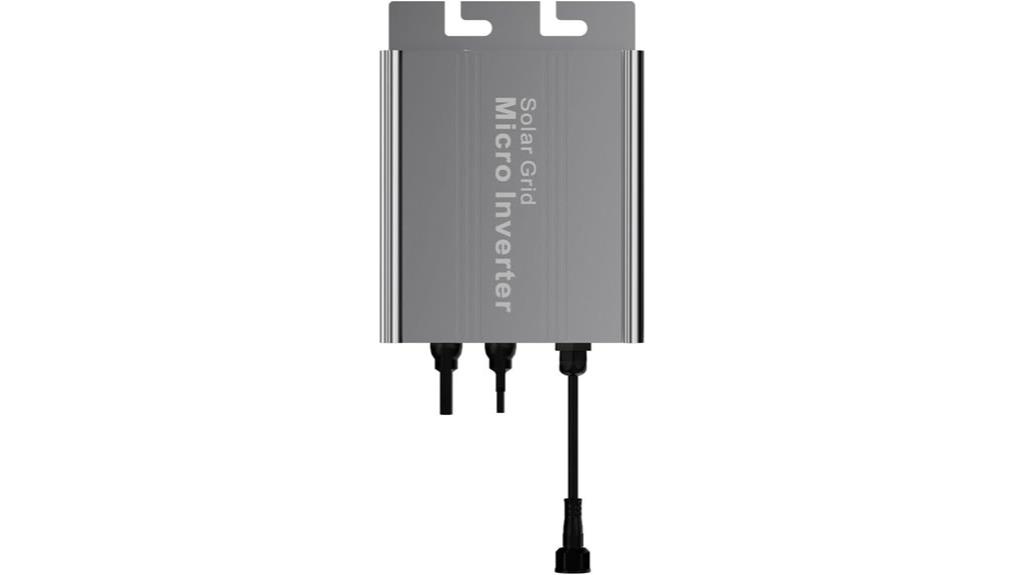
For small-scale home solar setups, the Y&H 500W Grid Tie Micro Inverter stands out as an efficient and cost-effective solution. It converts DC from solar panels into AC synchronized with the grid, supporting both 110V and 220V outlets. Designed for panels up to 500W, it works best with 36V panels and series-parallel configurations. While it offers a maximum efficiency of around 42%, it’s suitable for shaded or older panels. Keep in mind, it may overheat without proper cooling, and some users report durability issues. Overall, it’s a solid choice for those seeking a budget-friendly, small-scale grid-tie micro inverter.
Best For: small-scale homeowners seeking an affordable, efficient grid-tie micro inverter for basic solar panel setups.
Pros:
- Supports both 110V and 220V grid systems, offering versatile compatibility.
- Cost-effective solution suitable for panels up to 500W, ideal for budget-conscious projects.
- Compatible with series-parallel configurations, including shaded or older panels.
Cons:
- Can overheat without active cooling, potentially reducing lifespan and performance.
- Reports of durability issues and short operational lifespan in some user reviews.
- Limited efficiency (~42%) and potential derating under high load or hot conditions.
Yunir 600W Micro Solar Inverter for 2pcs 300W Solar Panels

The Yunir 600W Micro Solar Inverter is an ideal choice for homeowners seeking a reliable, easy-to-install solution for their 2x300W solar panels. It features MPPT grid tie functionality with a wide input voltage, maximizing energy harvest from your panels. Its automatic power stabilization guarantees consistent energy output after MPPT tracking, providing stable performance. The inverter supports effortless monitoring through a dedicated mobile app, allowing me to optimize efficiency easily. With an IP65 weatherproof design, it’s built to withstand outdoor conditions. Plus, its pure sine wave output guarantees reliable power for various appliances, making it a versatile and dependable option for residential solar setups.
Best For: homeowners and small-scale solar users seeking a reliable, easy-to-install inverter to maximize energy from 2x300W solar panels.
Pros:
- Efficient MPPT technology for optimal energy harvesting
- Weatherproof IP65 rating suitable for outdoor installation
- Supports remote monitoring via dedicated mobile app
Cons:
- Limited to 2 solar panels, not suitable for larger setups
- May require technical knowledge for installation and setup
- Pure sine wave output may be more costly than basic inverters
Renogy 300W Foldable Solar Panel Suitcase
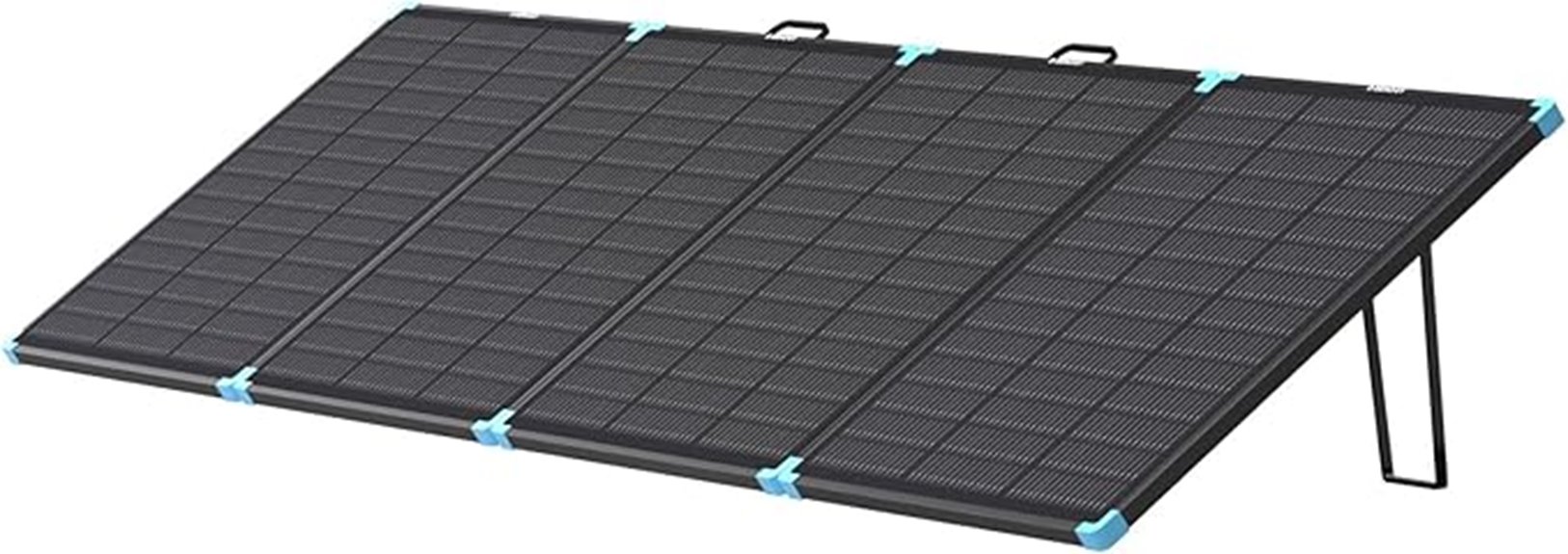
The Renogy 300W Foldable Solar Panel Suitcase stands out as an excellent choice for those needing portable, high-efficiency solar power in space-constrained environments. It uses industry-leading N-Type technology with 25% conversion efficiency, outperforming standard panels. Weighing just 18.74 lbs, it’s 17% lighter than similar options, making it easy to transport and set up without tools—just unfold and prop up the kickstands. Built with weather-resistant materials, including an IP67 waterproof rating and hail-resistant coating, it withstands extreme conditions. Its high efficiency guarantees reliable energy even in partial shade, making it perfect for RVs, camping, or emergency off-grid use.
Best For: outdoor enthusiasts, RV travelers, and emergency preppers seeking portable, high-efficiency solar power in space-constrained or challenging environments.
Pros:
- Industry-leading 25% N-Type technology for higher energy conversion efficiency.
- Lightweight and foldable design weighing only 18.74 lbs, easy to transport and set up without tools.
- Durable construction with IP67 waterproof rating and hail-resistant coating, suitable for extreme weather conditions.
Cons:
- Limited adjustable stands, which may result in less optimal angles depending on latitude and season.
- Smaller wire pouch size compared to previous models, restricting cable storage capacity.
- No included batteries or cables, requiring additional purchases for complete setup.
Ecosonique 300W Portable Solar Panel for Power Stations
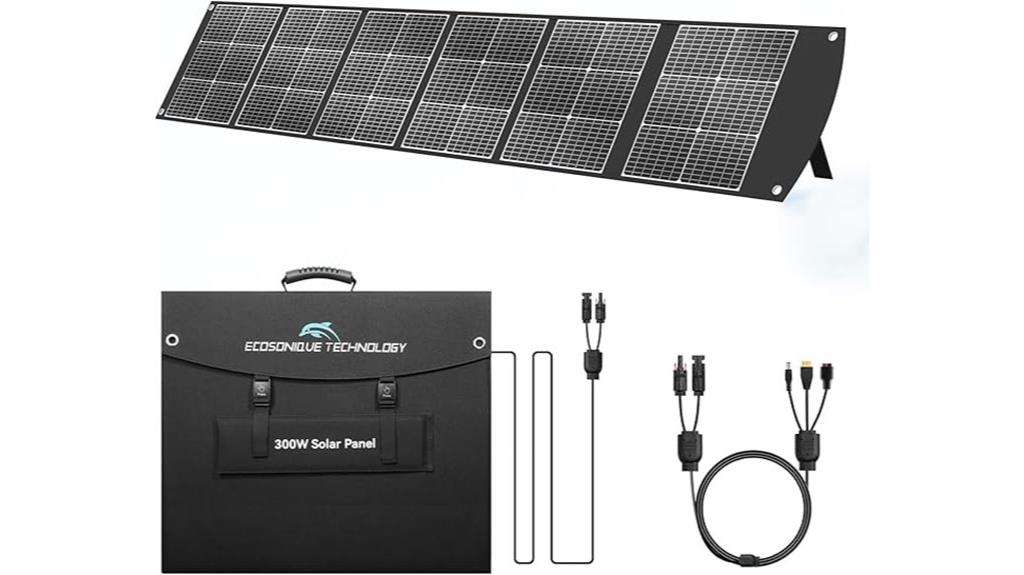
If you’re seeking a portable solar solution that combines durability with high efficiency, the Ecosonique 300W Portable Solar Panel is an excellent choice. Weighing just 15.4 pounds and folding into a compact 23x19x3 inches, it’s easy to carry and set up. Made with tear-resistant Oxford fabric and CPC lamination, it’s built to withstand harsh weather conditions, from freezing cold to intense heat. Equipped with adjustable kickstands, it maximizes sunlight exposure. Compatibility with popular power stations like EcoFlow and Jackery makes setup straightforward. With a 23.5% efficiency rate and a durable, waterproof design, it’s perfect for reliable outdoor power on the go.
Best For: outdoor enthusiasts, campers, and emergency preparedness individuals seeking a durable, high-efficiency portable solar panel for reliable power on the go.
Pros:
- Lightweight and foldable design for easy transport and setup
- High conversion efficiency of 23.5% for quick charging of power stations
- Weather-resistant construction with tear-proof Oxford fabric and CPC lamination
Cons:
- May require additional adapters for specific power station connections
- Slightly bulky when unfolded, which could limit portability in tight spaces
- Limited to compatibility with selected power station brands, possibly restricting use with less common devices
Y&H 350W Grid Tie Micro Inverter for Solar Panels
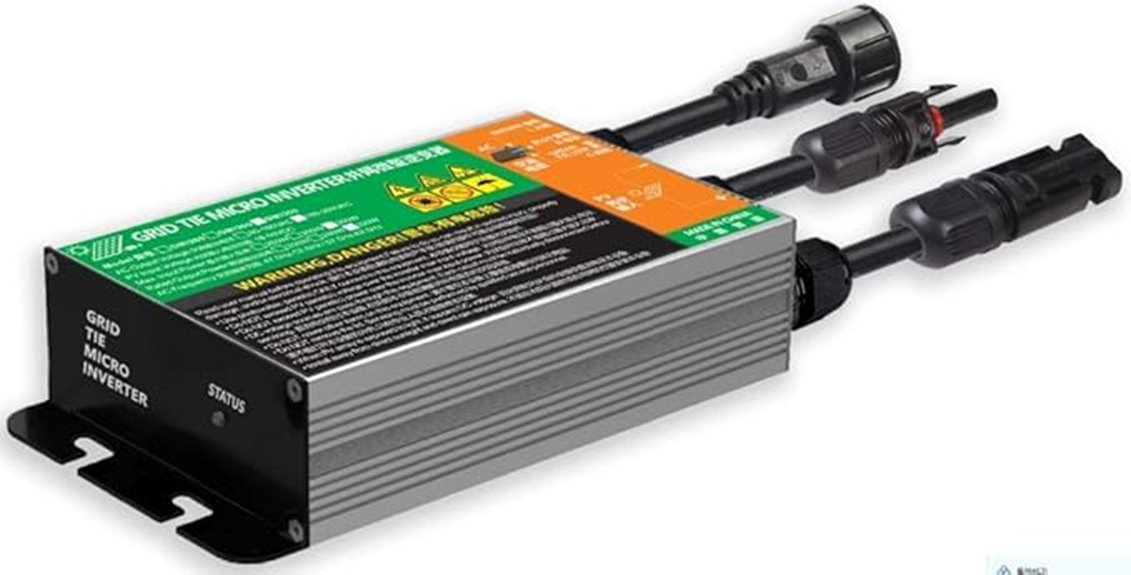
For those seeking an efficient and easy-to-install solution, the Y&H 350W Grid Tie Micro Inverter is ideal for small-scale solar setups. It’s compatible with 24V and 36V panels, with an AC output of 90-140V, making it versatile for various configurations. The inverter has a maximum power of 350W and an MPPT voltage range of 24-42V, ensuring ideal energy transfer when panel Vmp is between 30-42V. Proper matching of panel specs and correct installation are essential for peak performance. Keep in mind, it doesn’t support battery connections, so it’s best suited for grid-tied systems focused on maximizing solar efficiency.
Best For: homeowners or small-scale solar enthusiasts seeking an easy-to-install grid-tie inverter for 24V or 36V solar panels to maximize energy efficiency without battery storage.
Pros:
- Compatible with 24V and 36V solar panels, offering flexible installation options
- Easy to install with clear connection instructions, suitable for DIY setups
- Provides efficient energy transfer with MPPT voltage range of 24-42V
Cons:
- Does not support battery storage, limiting use to grid-tied systems only
- Must ensure panel Voc and Vmp are within specified ranges for optimal performance
- Maximum panel capacity is 350W, restricting larger or multiple panel configurations
Renogy 3000W Pure Sine Wave Power Inverter (PUH 3000W)
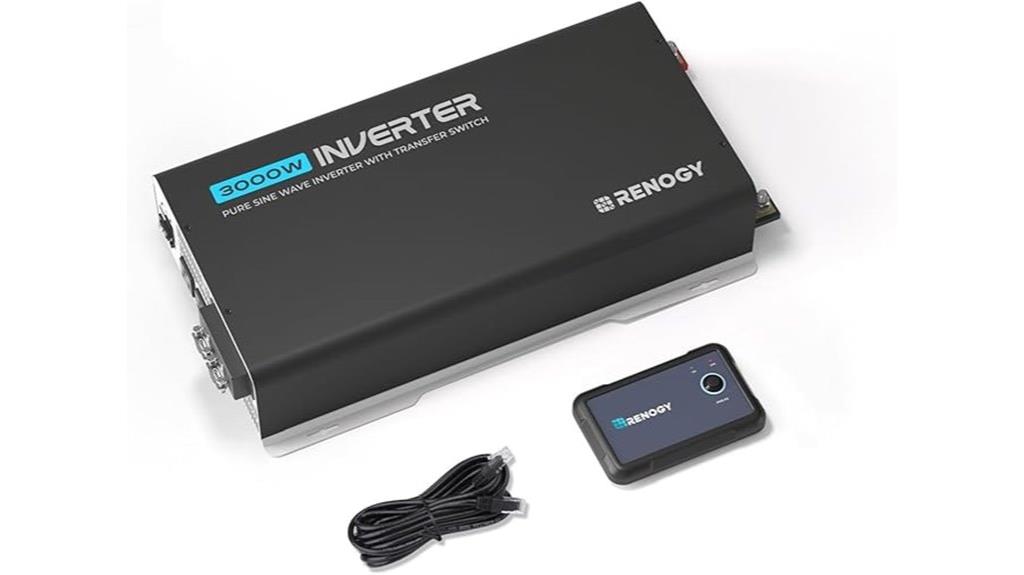
Renogy’s PUH 3000W inverter stands out as an excellent choice for those needing reliable, high-capacity power conversion in off-grid or mobile setups. It converts 12V DC to 110V AC with a continuous 3000W output and a 6000W surge peak, ensuring steady power for appliances, electronics, and small tools. Its pure sine wave output offers over 92% efficiency, delivering smooth, quiet operation and protecting sensitive devices. Equipped with a built-in transfer switch, Bluetooth monitoring, and multiple safety features, it’s versatile and user-friendly. Although some limitations exist, like startup frequency issues and reliance on 12V power for transfer, it’s a powerful, dependable option for RVs, camping, and emergency use.
Best For: campers, RV owners, and off-grid enthusiasts seeking reliable, high-capacity power conversion for sensitive electronics and appliances.
Pros:
- Efficient pure sine wave output with over 92% conversion efficiency ensures smooth operation and device protection.
- Built-in transfer switch with Bluetooth monitoring offers convenience and remote control capabilities.
- Compact size, lightweight design, and multiple safety features make it suitable for mobile and off-grid applications.
Cons:
- Reliance on 12V power for the transfer switch may lead to power loss if not properly maintained.
- Occasional startup frequency issues (50Hz instead of 60Hz) could risk damaging sensitive electronics.
- Some users report slow customer support and potential heating or melting problems without adequate ventilation.
300W Solar Panel Kit with Controller for RV and Camper
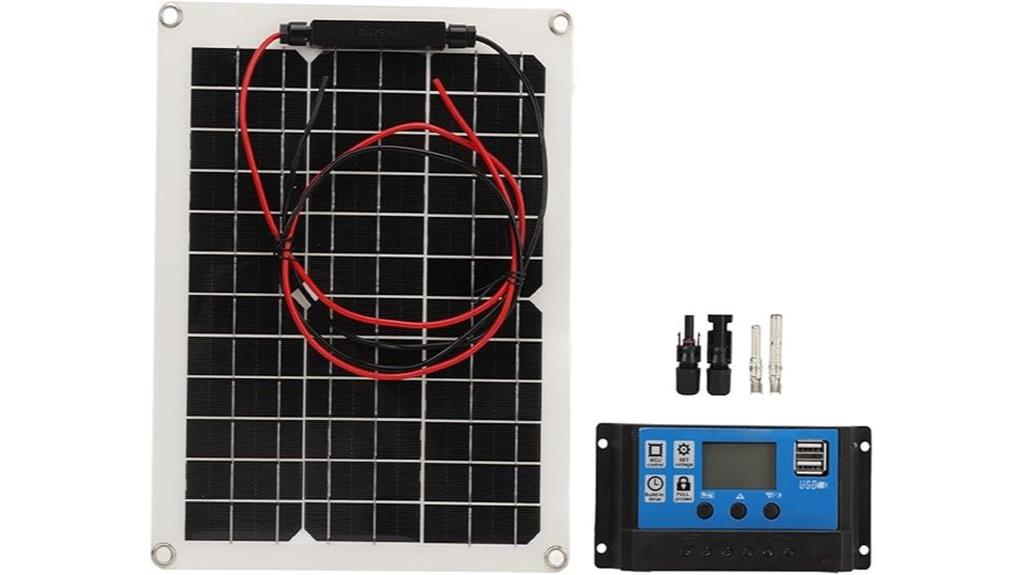
Looking for a reliable power solution for your RV or camper that’s easy to set up and provides consistent energy? The 300W Solar Panel Kit with Controller is perfect. It’s designed for outdoor use, compatible with 12V and 24V systems, and can charge devices like phones, tablets, and laptops, even high-power equipment. The waterproof 50A controller offers multiple safety protections, ensuring safe and stable operation. Built to withstand harsh conditions, it’s dustproof and waterproof, ideal for rainy or dusty environments. Plus, it’s an eco-friendly choice, harnessing solar energy to reduce your carbon footprint while keeping your outdoor adventures powered smoothly.
Best For: outdoor enthusiasts, RV owners, and campers seeking a reliable, eco-friendly power solution for their mobile or outdoor setups.
Pros:
- High efficiency 300W solar panel capable of charging multiple devices simultaneously
- Waterproof and durable construction suitable for harsh outdoor environments
- Equipped with a waterproof 50A controller offering comprehensive safety protections
Cons:
- May require some technical knowledge to install and connect properly
- Limited to 12V and 24V systems, not compatible with higher voltage setups
- Power output might be insufficient for very high-demand appliances or extended off-grid use
ExpertPower PowerWray FS300 Portable Solar Panel (300W)

If you’re seeking a portable solar solution that combines high efficiency with rugged durability, the ExpertPower PowerWray FS300 300W foldable solar panel is an excellent choice. It features monocrystalline silicon cells with up to 23.5% efficiency, delivering rapid charging and maximum power. Its durable aluminum and weather-resistant design, rated IP67, withstands rain and dust, making it perfect for outdoor use. Weighing about 22.5 pounds and folding down to a compact size, it’s easy to transport and set up. Compatible with popular power stations via MC4 connectors, it supports series and parallel connections to scale energy capacity for off-grid adventures.
Best For: outdoor enthusiasts, RV owners, and campers seeking a portable, durable, and efficient solar panel system for off-grid power needs.
Pros:
- High-efficiency monocrystalline silicon cells (up to 23.5%) for rapid charging and maximum power output
- Durable, weather-resistant construction rated IP67, suitable for rugged outdoor conditions
- Foldable and lightweight design with integrated handle for easy transport and setup
Cons:
- Weighs approximately 22.5 pounds, which may be heavy for some users to carry over long distances
- Requires compatible power stations with MC4 connectors for optimal use, possibly limiting plug-and-play options
- Limited to a maximum power output of 300W, which may not meet high energy demands for larger setups
Factors to Consider When Choosing Microinverter Solar 300W

When selecting a microinverter for a 300W system, I consider how well it matches my panels and its efficiency ratings to maximize performance. Durability and weatherproofing are essential since it needs to withstand the elements, while installation ease saves me time and effort. Additionally, I look at cooling features to ensure it stays cool and operates reliably over the long term.
Compatibility With Panels
Choosing the right microinverter for your 300W solar panels requires careful attention to compatibility factors. First, check that the microinverter’s maximum input voltage (Voc) matches or exceeds your panel’s open-circuit voltage to prevent overload. It’s also essential to confirm the inverter’s rated power capacity aligns with your total panel wattage for peak performance. Match the panel’s maximum power point voltage (Vmp) and current (Imp) within the microinverter’s MPPT voltage and current ranges to maximize efficiency. Additionally, verify that the number of panels connected in series or parallel doesn’t surpass the inverter’s input limits or wiring capacity. Lastly, confirm compatibility with your panel’s connector type, such as MC4, and ensure proper wiring to avoid connection issues or performance drops.
Power Efficiency Ratings
Power efficiency ratings are a critical factor to contemplate because they determine how effectively a microinverter converts DC solar energy into usable AC power. Typically expressed as a percentage, higher ratings—above 95%—indicate less energy loss during conversion, maximizing your system’s output. It’s important to bear in mind that efficiency can fluctuate with temperature, load, and input voltage, impacting real-world performance. MPPT technology plays a key role here by continuously adjusting input conditions to extract the maximum energy from your panels. A higher efficiency rating ensures that most of the solar energy captured is converted effectively, leading to better system performance and energy savings. When choosing a microinverter, prioritize those with top efficiency ratings to get the most from your solar investment.
Durability and Weatherproofing
Durability and weatherproofing are essential considerations because outdoor microinverters face constant exposure to the elements. I look for units with an IP65 or higher waterproof rating, guaranteeing they can handle rain, dust, and environmental challenges. Using sturdy materials like aluminum alloy enclosures and UV-resistant coatings markedly extends their lifespan. Proper heat dissipation features, such as self-cooling systems or heat sinks, prevent overheating during long outdoor hours. Additionally, the inverter should resist temperature extremes, performing reliably from -20°C to 65°C. Sealed connectors and weatherproof housings protect internal components from moisture ingress, reducing corrosion and short circuits. These features ensure the microinverter remains operational and efficient across diverse weather conditions, giving me confidence in its long-term resilience.
Installation Simplicity
When selecting a microinverter for a 300W solar panel system, ease of installation should be a top priority. Many models feature plug-and-play designs that make setup straightforward, even for those with limited electrical experience. They often include detailed instructions and pre-wired connectors, reducing the need for custom wiring or specialized tools. Proper mounting is simple too—just attach the inverter to a stable surface using the included hardware, with options for vertical or horizontal placement to improve cooling. Clear, keyed or color-coded connectors minimize wiring errors, saving time and hassle. Additionally, integrated monitoring features allow for quick setup and immediate performance checks, ensuring your system is running efficiently right from the start.
Cooling and Heat Management
Have you considered how heat management impacts the performance and lifespan of your microinverter? Proper heat dissipation is essential because excessive internal temperatures can reduce efficiency and shorten its lifespan. Active cooling methods, like built-in fans or liquid cooling systems, help keep temperatures in check during high power loads. Additionally, placing your microinverter in well-ventilated areas and ensuring good airflow prevents overheating. Using heat sinks or thermal interface materials can also improve heat transfer away from critical components, maintaining ideal operation. Monitoring temperature levels and ensuring the enclosure is weatherproof and properly ventilated further safeguards against thermal stress. Effective heat management not only boosts efficiency but also extends your microinverter’s durability, making it a key factor in choosing the right system.
Safety and Certification
Choosing the right microinverter involves prioritizing safety and certification to guarantee reliable and compliant operation. I look for models with certifications like UL 1741, CSA, or CE, ensuring they meet safety standards and local electrical codes. Built-in protections such as over-voltage, under-voltage, over-temperature, and short-circuit safeguards are essential to prevent damage and keep the system running smoothly. I also verify that the inverter complies with electromagnetic compatibility standards like EN50081 and EN50082 to minimize electrical interference. For outdoor installations, I ensure it has an IP65 or higher waterproof and dustproof rating to withstand environmental conditions. Ultimately, certified safety features like rapid shutoff and surge protection are vital for protecting both the system and users during faults or surges.
Frequently Asked Questions
How Do Microinverters Handle Shading on Individual Panels?
Microinverters handle shading on individual panels by optimizing each panel’s performance separately. When a panel is shaded, the microinverter adjusts its output to prevent the shading from affecting the entire system’s efficiency. I’ve seen this in action; shading on one panel doesn’t drag down the others, so your system continues to generate power efficiently. It’s one of the main reasons I prefer microinverters over string inverters.
What Is the Typical Lifespan of a 300W Microinverter?
Think of a 300W microinverter as a reliable partner that stands the test of time. Typically, it lasts around 10 to 15 years, much like a seasoned oak enduring through seasons. Proper installation, quality components, and regular maintenance can extend that lifespan. I’ve seen well-maintained microinverters continue functioning smoothly, ensuring your solar system’s efficiency and saving you money over the years.
Are 300W Microinverters Compatible With All Solar Panel Brands?
Yes, 300W microinverters are generally compatible with most solar panel brands, but I always recommend double-checking their specifications. Compatibility depends on voltage and connector types, so I verify the inverter’s input range matches my panels. I also review manufacturer guidelines. This way, I can be confident my system will perform efficiently and reliably, regardless of the brand I choose.
How Do Microinverters Improve System Safety and Reliability?
Ever imagine a solar system that’s safer and more reliable? Microinverters do just that by converting DC to AC power right at each panel, reducing potential shock hazards and system failures. This decentralization means if one microinverter fails, the entire system isn’t affected. I’ve seen how this setup enhances safety, minimizes downtime, and boosts overall reliability—making your solar investment smarter and more secure.
Can Microinverters Be Used in Off-Grid Solar Power Systems?
Yes, I can definitely use microinverters in off-grid solar systems. They’re ideal because they optimize each panel’s performance individually, which is essential when sunlight varies. Microinverters also help with system reliability and safety, especially since off-grid setups often lack the same protections as grid-tied systems. I find them perfect for small to medium off-grid projects, ensuring maximum efficiency and easier troubleshooting.
Conclusion
Choosing the right 300W microinverter system is like finding the perfect puzzle piece—it completes your solar setup seamlessly. With so many options tailored for efficiency and reliability, I recommend matching your needs carefully. Remember, the right microinverter can turn your solar panels into a powerhouse, lighting up your life while saving you money. So, pick smart, and let your solar journey shine brighter than ever!
